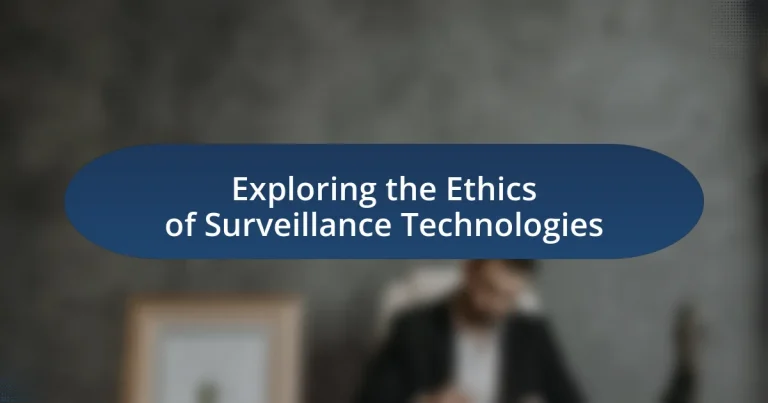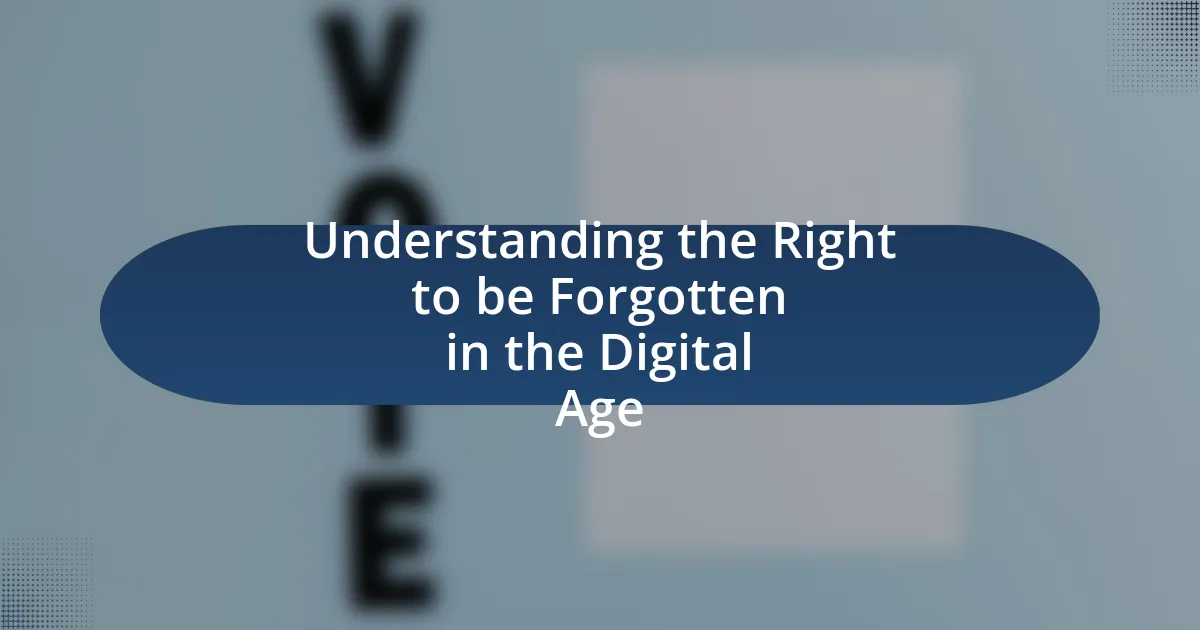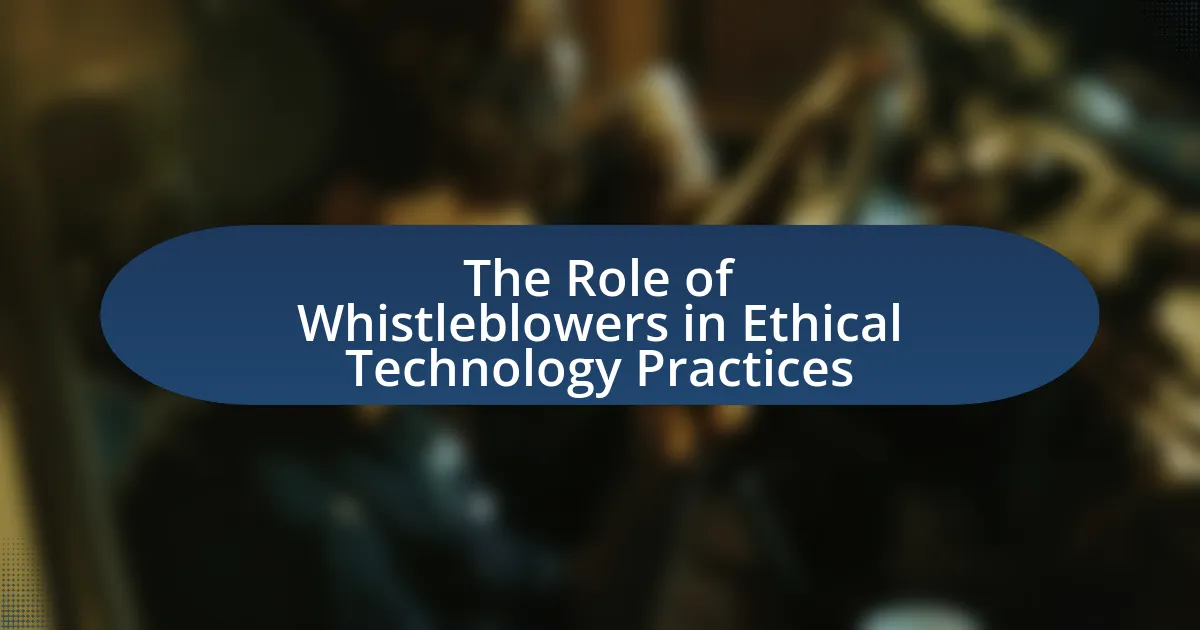Surveillance technologies encompass tools and systems designed to monitor, collect, and analyze information about individuals or groups, often without their consent. This article explores the functionality, types, and primary purposes of these technologies, highlighting their roles in enhancing security and law enforcement. It also addresses the ethical concerns surrounding surveillance, including privacy violations, potential misuse of data, and the impact on civil liberties. Furthermore, the article examines the implications of mass surveillance on individual freedoms, cultural perceptions of privacy, and the need for regulatory frameworks to balance security benefits with ethical considerations.
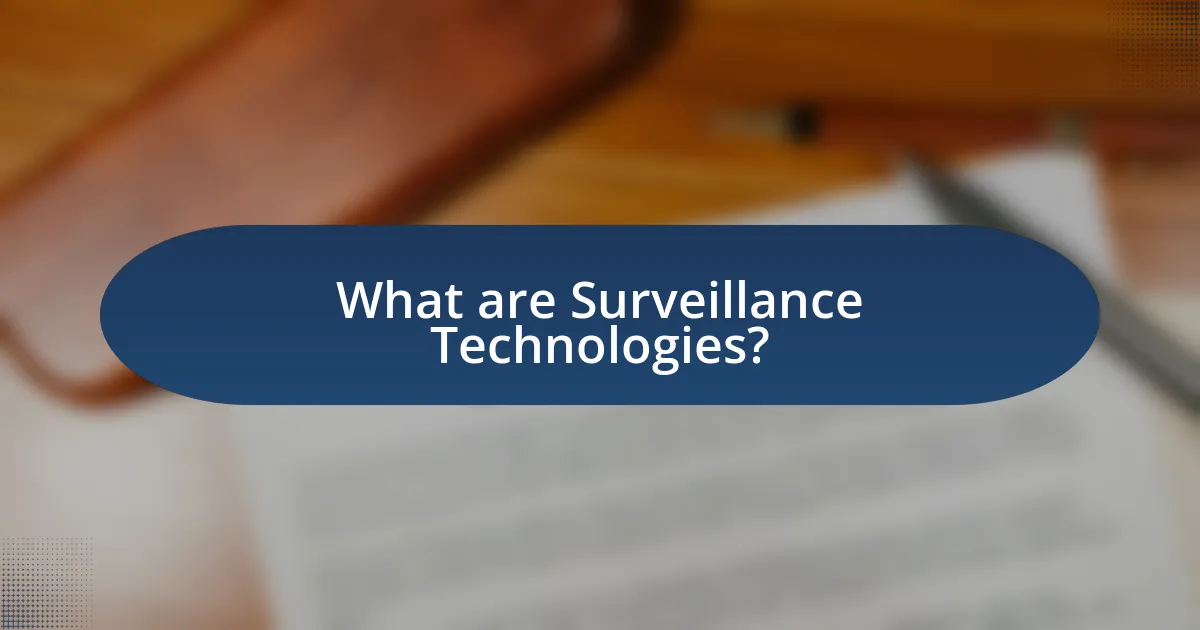
What are Surveillance Technologies?
Surveillance technologies are tools and systems used to monitor, collect, and analyze information about individuals or groups, often without their consent. These technologies include video cameras, drones, biometric systems, and software for data analysis, which are employed in various sectors such as law enforcement, security, and public safety. For instance, the global market for surveillance equipment was valued at approximately $45 billion in 2020 and is projected to grow, indicating the widespread adoption and reliance on these technologies.
How do Surveillance Technologies function?
Surveillance technologies function by collecting, analyzing, and storing data to monitor individuals or environments. These technologies utilize various methods such as cameras, sensors, and software algorithms to capture real-time information. For instance, closed-circuit television (CCTV) systems record video footage, while facial recognition software analyzes images to identify individuals. Data collected is often processed using machine learning algorithms to detect patterns or anomalies, enhancing the effectiveness of monitoring. The integration of these technologies allows for comprehensive surveillance capabilities, which can be seen in applications ranging from public safety to corporate security.
What types of Surveillance Technologies are commonly used?
Commonly used surveillance technologies include closed-circuit television (CCTV), drones, biometric systems, and GPS tracking. CCTV systems are widely deployed in public spaces for monitoring and crime prevention, with millions of cameras installed globally. Drones are increasingly utilized for aerial surveillance in various sectors, including law enforcement and agriculture, providing real-time data collection. Biometric systems, such as fingerprint and facial recognition technologies, are employed for identity verification in security applications, with facial recognition alone being used by law enforcement agencies in numerous countries. GPS tracking is commonly used for monitoring vehicle movements and personal tracking, enhancing security and logistics management. These technologies are integral to modern surveillance practices, reflecting their widespread adoption and application across different domains.
How do these technologies collect and process data?
Surveillance technologies collect and process data through various methods such as video monitoring, biometric scanning, and digital tracking. These technologies utilize cameras, sensors, and software algorithms to capture real-time information about individuals and their activities. For instance, facial recognition systems analyze facial features from video feeds to identify individuals, while location tracking uses GPS data to monitor movements. The data collected is then processed using machine learning algorithms to analyze patterns, generate insights, and inform decision-making. This processing often involves storing vast amounts of data in databases, which can be accessed for further analysis or reporting.
What are the primary purposes of Surveillance Technologies?
The primary purposes of surveillance technologies are to enhance security, monitor behavior, and gather data for analysis. These technologies are widely used in law enforcement to prevent crime, in businesses to ensure safety and compliance, and in public spaces to maintain order. For instance, according to a report by the International Association of Chiefs of Police, surveillance cameras can reduce crime rates by up to 50% in monitored areas. Additionally, surveillance technologies are employed in various sectors, including healthcare and transportation, to improve operational efficiency and safety.
How do Surveillance Technologies enhance security?
Surveillance technologies enhance security by providing real-time monitoring and data collection that help prevent and respond to criminal activities. These technologies, such as CCTV cameras, drones, and biometric systems, enable law enforcement and security personnel to detect suspicious behavior, gather evidence, and ensure public safety. For instance, studies have shown that areas with increased surveillance experience a significant reduction in crime rates, with some reports indicating a decrease of up to 30% in specific neighborhoods. This effectiveness is attributed to the deterrent effect that visible surveillance has on potential offenders, as well as the ability to quickly identify and apprehend individuals involved in illegal activities.
What role do Surveillance Technologies play in law enforcement?
Surveillance technologies play a critical role in law enforcement by enhancing crime prevention, investigation, and public safety. These technologies, including CCTV cameras, drones, and facial recognition systems, enable law enforcement agencies to monitor public spaces, gather evidence, and identify suspects more efficiently. For instance, a study by the Urban Institute found that cities employing surveillance cameras experienced a significant reduction in crime rates, demonstrating the effectiveness of these technologies in deterring criminal activity. Additionally, the use of data analytics in conjunction with surveillance footage allows for more informed decision-making and resource allocation within police departments.
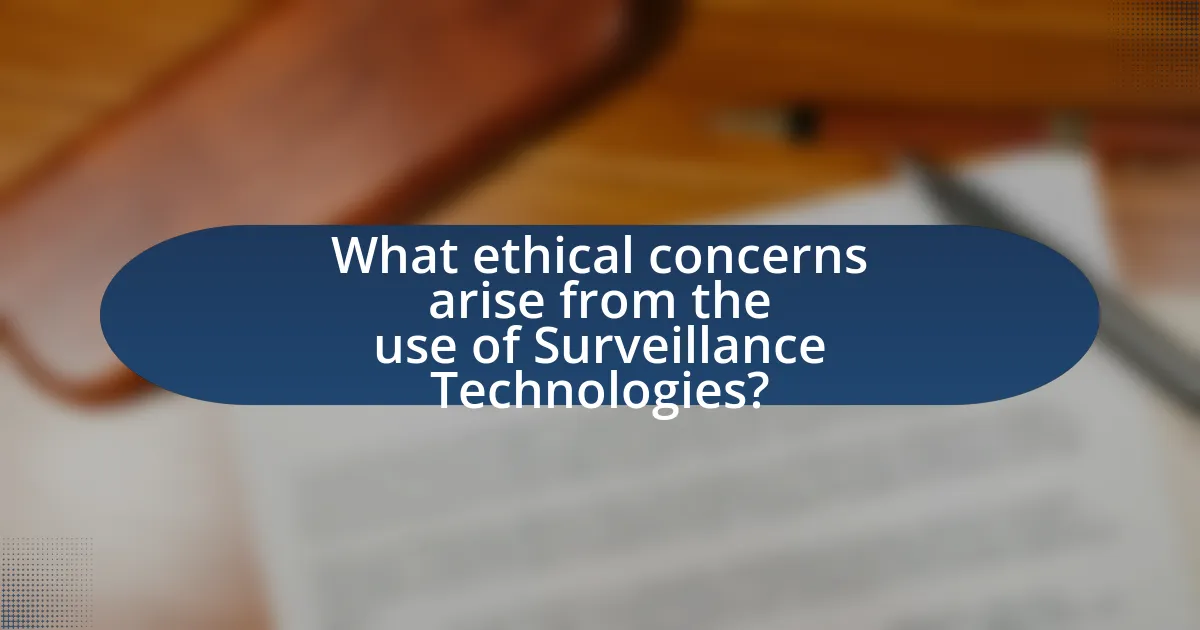
What ethical concerns arise from the use of Surveillance Technologies?
The ethical concerns arising from the use of surveillance technologies include privacy violations, potential misuse of data, and the erosion of civil liberties. Privacy violations occur when individuals are monitored without their consent, leading to a lack of control over personal information. For instance, a study by the Electronic Frontier Foundation highlights that pervasive surveillance can create a chilling effect on free speech and assembly, as individuals may alter their behavior if they believe they are being watched. Additionally, the potential misuse of data by authorities or corporations raises concerns about discrimination and profiling, as seen in cases where surveillance data has been used to target specific communities unjustly. Lastly, the erosion of civil liberties is evident when surveillance technologies are employed without adequate oversight, resulting in a society where individuals may feel constantly monitored, undermining democratic principles.
How do Surveillance Technologies impact privacy rights?
Surveillance technologies significantly impact privacy rights by enabling extensive monitoring of individuals without their consent. These technologies, such as facial recognition systems and mass data collection, often infringe upon the expectation of privacy that individuals have in public and private spaces. For instance, a report by the Electronic Frontier Foundation highlights that the use of surveillance cameras in public areas can lead to the tracking of individuals’ movements and behaviors, effectively eroding personal privacy. Furthermore, legal frameworks in many jurisdictions struggle to keep pace with technological advancements, resulting in inadequate protections for individuals against unwarranted surveillance. This imbalance raises ethical concerns regarding the right to privacy and the potential for abuse of power by authorities and corporations.
What are the implications of mass surveillance on individual freedoms?
Mass surveillance significantly undermines individual freedoms by eroding privacy rights and fostering a culture of fear and self-censorship. When governments or organizations monitor citizens’ activities, it creates an environment where individuals may feel compelled to alter their behavior due to the constant possibility of being watched. Research by the American Civil Liberties Union indicates that mass surveillance disproportionately affects marginalized communities, leading to increased discrimination and social control. Furthermore, historical examples, such as the Stasi in East Germany, illustrate how pervasive surveillance can lead to a loss of trust in society and the suppression of dissent. These implications highlight the critical tension between security measures and the preservation of fundamental human rights.
How do different cultures perceive privacy in relation to Surveillance Technologies?
Different cultures perceive privacy in relation to surveillance technologies in varied ways, influenced by historical, social, and legal contexts. For instance, in Western cultures, particularly in the United States and parts of Europe, privacy is often viewed as a fundamental human right, leading to strong legal frameworks like the General Data Protection Regulation (GDPR) in Europe, which emphasizes individual consent and data protection. Conversely, in many Asian cultures, such as in China, there is a greater acceptance of surveillance technologies as tools for social stability and security, often prioritizing collective safety over individual privacy. This is evidenced by the extensive use of surveillance cameras and social credit systems in China, which are supported by the government as measures to enhance public order. These cultural differences highlight how societal values shape the understanding and acceptance of privacy in the context of surveillance technologies.
What are the potential consequences of Surveillance Technologies on society?
Surveillance technologies can lead to significant consequences for society, including privacy erosion, increased state control, and potential misuse of data. The widespread implementation of surveillance systems, such as facial recognition and mass data collection, diminishes individual privacy rights, as evidenced by studies showing that 79% of Americans express concern over their privacy in the digital age. Furthermore, these technologies can enable authoritarian practices, as seen in countries where surveillance is used to suppress dissent and monitor citizens. The potential for data misuse is also high; incidents of data breaches and unauthorized access to personal information have been reported, highlighting the risks associated with centralized data storage.
How can Surveillance Technologies lead to discrimination or bias?
Surveillance technologies can lead to discrimination or bias by perpetuating existing societal inequalities through biased algorithms and data collection practices. For instance, facial recognition systems have been shown to misidentify individuals from minority groups at significantly higher rates than those from majority groups, with studies indicating that Black individuals are misidentified up to 35% more often than white individuals. This bias arises from training datasets that lack diversity, leading to skewed outcomes that reinforce stereotypes and systemic discrimination. Additionally, the deployment of surveillance in specific neighborhoods often targets marginalized communities, exacerbating social disparities and fostering an environment of mistrust and fear.
What are the risks of misuse of Surveillance Technologies by authorities?
The risks of misuse of surveillance technologies by authorities include invasion of privacy, abuse of power, and erosion of civil liberties. Invasion of privacy occurs when authorities monitor individuals without consent, leading to unauthorized access to personal information. Abuse of power can manifest through selective enforcement or targeting specific groups, which can result in discrimination and social unrest. Erosion of civil liberties happens when surveillance becomes normalized, potentially leading to a society where individuals feel constantly watched, stifling free expression and dissent. Historical examples, such as the NSA’s mass surveillance programs revealed by Edward Snowden, illustrate these risks, showing how surveillance can be misused to infringe on individual rights and freedoms.
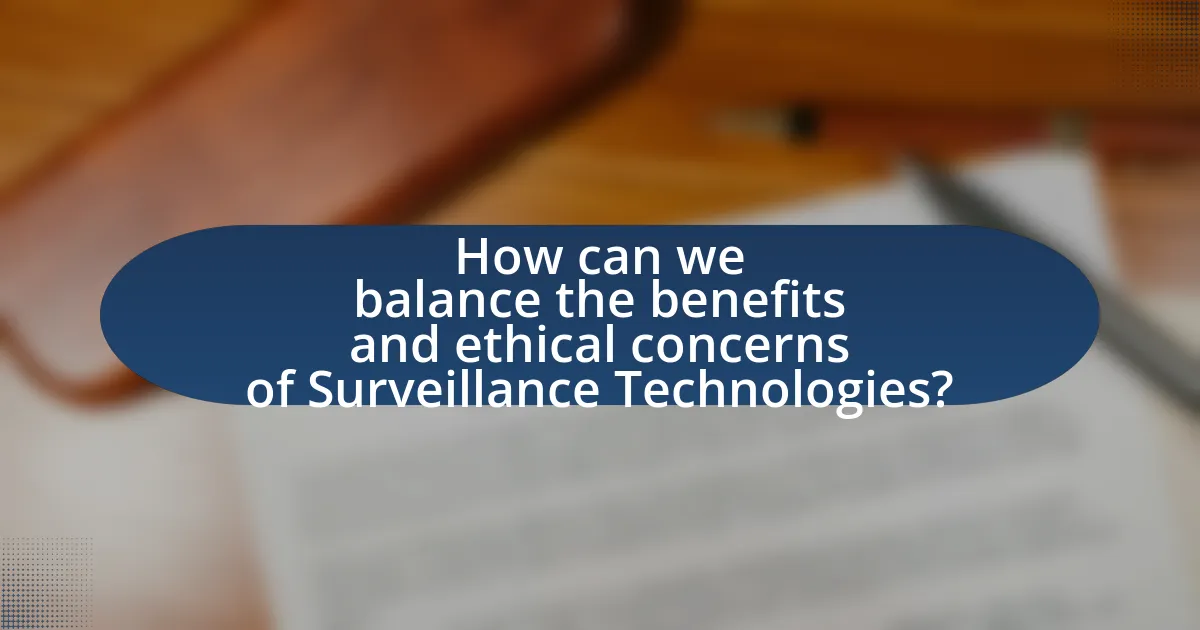
How can we balance the benefits and ethical concerns of Surveillance Technologies?
To balance the benefits and ethical concerns of surveillance technologies, it is essential to implement robust regulatory frameworks that ensure transparency and accountability. These frameworks should include clear guidelines on data collection, usage, and retention, as well as mechanisms for public oversight. For instance, the General Data Protection Regulation (GDPR) in the European Union establishes strict rules on personal data processing, which helps mitigate privacy risks while allowing for the benefits of surveillance in crime prevention and public safety. Additionally, engaging stakeholders, including civil society, in the policymaking process can foster a more balanced approach that considers both security needs and individual rights.
What regulations exist to govern the use of Surveillance Technologies?
Regulations governing the use of surveillance technologies include the General Data Protection Regulation (GDPR) in the European Union, which mandates strict guidelines on data collection and processing, ensuring individuals’ privacy rights are protected. Additionally, the U.S. has various federal and state laws, such as the Electronic Communications Privacy Act (ECPA), which regulates government access to electronic communications and data. These regulations aim to balance the need for security and surveillance with the protection of individual privacy rights, as evidenced by ongoing legal challenges and public discourse surrounding their implementation and effectiveness.
How effective are current laws in protecting citizens’ rights?
Current laws are moderately effective in protecting citizens’ rights, particularly in the context of surveillance technologies. For instance, the Fourth Amendment of the U.S. Constitution safeguards against unreasonable searches and seizures, which is crucial in regulating surveillance practices. However, the rapid advancement of technology often outpaces legislative measures, leading to gaps in protection. A report by the Electronic Frontier Foundation highlights that many surveillance practices, such as data collection by law enforcement without warrants, undermine citizens’ privacy rights. Additionally, laws like the General Data Protection Regulation (GDPR) in Europe provide stronger protections, yet enforcement varies significantly across jurisdictions. Thus, while existing laws offer some level of protection, their effectiveness is often compromised by technological advancements and inconsistent enforcement.
What role do organizations play in ensuring ethical use of Surveillance Technologies?
Organizations play a crucial role in ensuring the ethical use of surveillance technologies by establishing policies, guidelines, and oversight mechanisms that govern their deployment and use. These entities are responsible for creating frameworks that prioritize privacy, transparency, and accountability, thereby mitigating potential abuses of surveillance capabilities. For instance, organizations can implement data protection policies that comply with regulations such as the General Data Protection Regulation (GDPR), which mandates strict guidelines on data collection and usage. Additionally, organizations can conduct regular audits and assessments to evaluate the impact of surveillance technologies on individual rights and societal norms, ensuring that their practices align with ethical standards. By fostering a culture of ethical awareness and responsibility, organizations can significantly influence the responsible use of surveillance technologies in society.
What best practices can be implemented for ethical Surveillance Technology use?
Best practices for ethical surveillance technology use include transparency, data minimization, and accountability. Transparency involves informing the public about surveillance practices, including what data is collected and how it is used, which fosters trust and allows for public scrutiny. Data minimization requires collecting only the information necessary for a specific purpose, thereby reducing the risk of misuse and protecting individual privacy. Accountability ensures that organizations and individuals responsible for surveillance are held to ethical standards and legal regulations, which can be reinforced through regular audits and independent oversight. These practices are supported by frameworks such as the General Data Protection Regulation (GDPR), which emphasizes the importance of privacy and data protection in surveillance activities.
How can transparency be increased in Surveillance Technology operations?
Transparency in Surveillance Technology operations can be increased by implementing clear policies and public reporting mechanisms. Establishing guidelines that dictate how surveillance data is collected, stored, and used ensures accountability. For instance, jurisdictions that have enacted laws requiring regular audits and public disclosures of surveillance practices, such as the California Electronic Communications Privacy Act, demonstrate a commitment to transparency. Additionally, involving community stakeholders in discussions about surveillance practices fosters trust and allows for public input, further enhancing transparency.
What measures can be taken to ensure accountability in Surveillance practices?
To ensure accountability in surveillance practices, implementing robust oversight mechanisms is essential. These mechanisms can include independent audits, clear legal frameworks, and transparency requirements that mandate regular reporting on surveillance activities. For instance, the establishment of independent review boards can provide checks on surveillance practices, ensuring they comply with legal standards and ethical guidelines. Additionally, countries like Germany have enacted strict data protection laws that require organizations to justify their surveillance activities, thereby enhancing accountability. Such measures not only promote responsible use of surveillance technologies but also protect individual privacy rights, aligning with ethical standards in surveillance practices.
What are the future trends in Surveillance Technologies and ethics?
Future trends in surveillance technologies include increased integration of artificial intelligence, enhanced data analytics capabilities, and a growing emphasis on privacy-preserving techniques. The integration of AI allows for more sophisticated pattern recognition and predictive analytics, enabling real-time monitoring and decision-making. Enhanced data analytics capabilities facilitate the processing of vast amounts of data collected from various sources, improving the effectiveness of surveillance systems. Additionally, there is a rising focus on ethical considerations, such as the implementation of privacy-preserving techniques like differential privacy and federated learning, which aim to protect individual data while still allowing for valuable insights. These trends reflect a balancing act between technological advancement and the ethical implications of surveillance practices, as seen in recent discussions surrounding legislation like the General Data Protection Regulation (GDPR) in Europe, which emphasizes the need for ethical frameworks in data handling and surveillance.
How might advancements in technology change the ethical landscape?
Advancements in technology can significantly alter the ethical landscape by introducing new dilemmas related to privacy, consent, and accountability. For instance, the proliferation of surveillance technologies, such as facial recognition and data analytics, raises concerns about individual privacy rights and the potential for misuse by governments and corporations. A study by the Electronic Frontier Foundation highlights that these technologies can lead to mass surveillance, which infringes on civil liberties and can disproportionately affect marginalized communities. Furthermore, as artificial intelligence systems become more integrated into decision-making processes, ethical questions regarding bias, transparency, and the potential for autonomous decision-making arise, necessitating a reevaluation of existing ethical frameworks.
What proactive steps can society take to address emerging ethical challenges?
Society can implement regulatory frameworks to address emerging ethical challenges associated with surveillance technologies. Establishing clear guidelines and laws can help ensure that surveillance practices respect individual privacy rights and promote transparency. For instance, the General Data Protection Regulation (GDPR) in the European Union sets strict rules on data collection and processing, which serves as a model for protecting citizens’ rights. Additionally, engaging in public discourse and involving diverse stakeholders in decision-making processes can foster a more inclusive approach to ethical considerations. Research indicates that participatory governance can lead to more equitable outcomes in technology deployment, as seen in studies by the Berkman Klein Center for Internet & Society at Harvard University.
